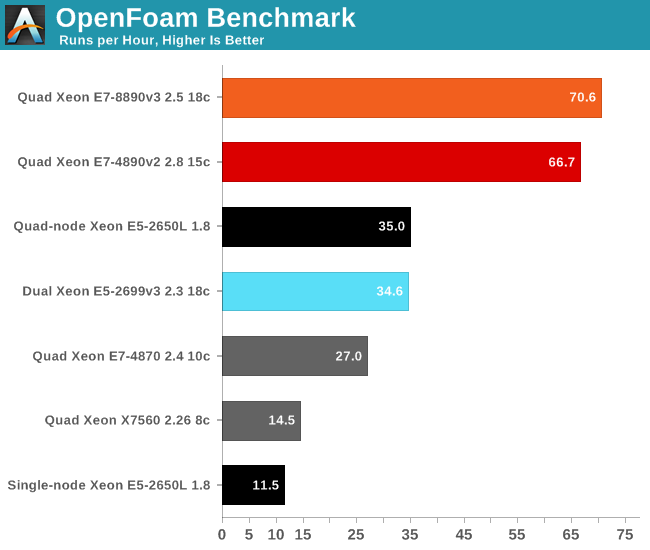The Intel Xeon E7-8800 v3 Review: The POWER8 Killer?
by Johan De Gelas on May 8, 2015 8:00 AM EST- Posted in
- CPUs
- IT Computing
- Intel
- Xeon
- Haswell
- Enterprise
- server
- Enterprise CPUs
- POWER
- POWER8
HPC: OpenFoam
Computational Fluid Dynamics is a very important part of the HPC world. Several readers told us that we should look into OpenFoam, and my lab was able to work with the professionals of Actiflow. Actiflow specializes in combining aerodynamics and product design. Calculating aerodynamics involves the use of CFD software, and Actiflow uses OpenFoam to accomplish this. To give you an idea what these skilled engineers can do, they worked with Ferrari to improve the underbody airflow of the Ferrari 599 and increase its downforce.
We were allowed to use one of their test cases as a benchmark, but we are not allowed to discuss the specific solver. All tests were done on OpenFoam 2.2.1 and openmpi-1.6.3.
Many CFD calculations do not scale well on clusters, that is unless you use InfiniBand. InfiniBand switches are quite expensive and even then there are limits to scaling. We do not have an InfiniBand switch in the lab, unfortunately. Although it's not as low latency as InfiniBand, we do have a good 10G Ethernet infrastructure, which performs rather well. So we can compare our newest Xeon server with a basic cluster.
We also found AVX code inside OpenFoam 2.2.1, so we assume that this is one of the cases where AVX improves FP performance.

Unless you recompile and tune your code for AVX2, the new Xeon E7 v3 is hardly faster than the previous one. The reason may be that the new Xeon can sometimes go as low as 2.1 GHz running AVX code due to the immense power load AVX2 workloads can cause, while the older E7 v2 is capable of sustaining 2.8 GHz.










146 Comments
View All Comments
MyNuts - Tuesday, May 12, 2015 - link
Charles Babbage would be upsetquadibloc - Thursday, May 14, 2015 - link
I'm shocked to hear that Oracle and IBM are charging more for their SPARC and PowerPC chips, respectively, than Intel is charging for comparable x86 chips - or, at least, I presume they are, if servers using those chips are more expensive. Since x86 has the enormous advantage of being able to run Microsoft Windows, the only way other ISAs can be viable is if they offer better performance or a lower price.Kevin G - Thursday, May 14, 2015 - link
Actually IBM comes in cheaper than Intel for comparable POWER8 hardware. IBM now is offering the processor to outside system builders so the actual prices are some what known. Tyan used to have the raw prices on their site but I can't find them again.Regardless, this article indicates that they top out at $3000 which is less than equivalent Xeon E7's.
kgardas - Thursday, May 21, 2015 - link
Sure, SPARC and POWER are (was in case of POWER) more expensive, but usually hardware price is nothing in comparison with software price if you are running enterprise. Also SPARC is also Oracle preferred over POWER/Itanium by Oracle's price ratios... Anyway, POWER8 looks so powerful that it may even be cheaper software wise in comparison with SPARC, but that would need some clever Oracle DB benchmarking...HighTech4US - Friday, May 15, 2015 - link
Power 9 will be available when?Phiro69 - Friday, May 15, 2015 - link
I wanted to compare the E7's in this review to the E5's reviewed a few months back in your benchmark comparison tool, but I'm not seeing any of this data in it? Is it going to be there?